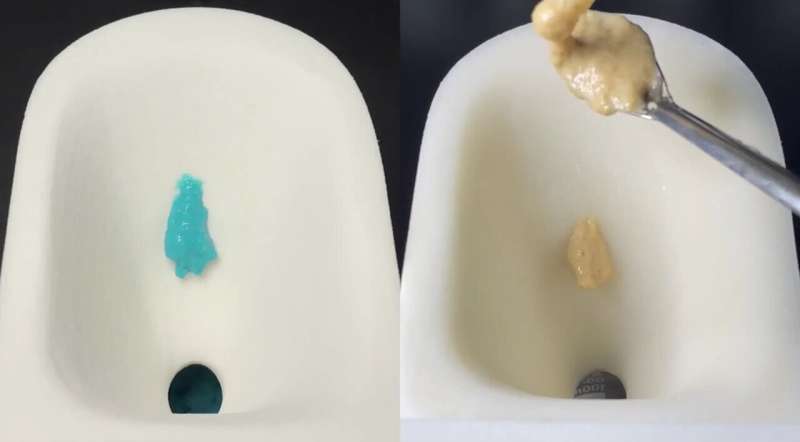August 23, 2023 report
This article has been reviewed according to Science X's editorial process and policies. Editors have highlighted the following attributes while ensuring the content's credibility:
fact-checked
trusted source
proofread
Nothing sticks: New silicon-infused 3D printed toilet bowl repels all

Going to the bathroom may not rank among the most pleasant activities of a day, but given some context, we should be quite appreciative.
For instance, the Sumerians of Mesopotamia, the cradle of civilization, relieved themselves sitting atop ceramic tubes situated high above deep pits where waste accumulated and sat. There was no plumbing.
The Greeks stepped up in 1700 BC and constructed the Palace of Knossos, creating an early sewage system, which incorporated large clay pans connected to a running water supply.
By 315 AD, the Romans—who were so fond of partying that they had a god of parties, Bacchus—had built a huge, 144-seat toilet sanctuary where they sat closely together and treated the activity as a social event. They met friends, discussed politics, and caught up with family affairs and local gossip, all while attending to nature. Their togas provided a degree of privacy, but not completely. There was no evidence men and women were segregated.
With no toilet paper, not to mention smart toilets, they shared communal sea sponges attached to sticks—tersorium, which literally means "a wiping thing"—to clean themselves. This was not very sanitary, and existing before knowledge of how disease spread, likely was a frequent source of infection and disease.
Happily, John Harrington, the godson of Queen Elizabeth I, invented a private flushing toilet containing a water tank and pipes to carry waste away. Two centuries later, Alexander Cummins designed the S-shaped pipe that ejected waste water while suppressing odors.
Fast forward to today, where for just $8,625, you can own a smart toilet with heated seats, ambient lighting, a built-in speaker system, a variety of stream pressures that ensures one's butt is pampered, massaged and fully cleaned each time. It offers instant seat opening and automatic flush, pre-misting for more effective rinsing, and employs Alexa to help users craft the ultimate toilet experience. The Sumerians would be impressed.
The intricacies and workings of toilets have drawn the interest of a team of researchers at Huazhong University of Science and Technology in Wuhan, China. Reflecting on thousands of years of toilet history, they sought a better toilet bowl. Now, Yike Li and his colleagues have come up with a feature we all can appreciate: a super-slippery toilet bowl to which virtually nothing can stick. Their work is published in the journal Advanced Engineering Materials.
Using a 3D printing process, they combined plastic and hydrophobic sand grains and injected the mixture with a silicon-based oil. The result was a slippery bowl that flushed everything they threw at it, including muddy water, rice porridge, milk, honey, starch-filled gel and synthetic feces. Nothing stuck, even after they sandpapered the surface more than 1,000 times. The bowl remained slippery even after researchers scraped it with a Stanley knife and file.
They call their invention ARSSFT—Abrasion-Resistant Super-Slippery Flush Toilet.
Toilets previously have been treated with nonstick sprays, but they eventually wear off. The ARSSFT model bowl, one-tenth the size of a regular toilet, retains its resistance since the silicon oil penetrates deep into the bowl's surface, close enough to the surface to ensure non-stick capabilities but deep enough to not leach out.
According to the research paper, the researchers were motivated by more than just the challenge of a cleaner toilet bowl.
Huazhong University's Li explained, "Globally, toilet flushing alone consumes more than 141 billion liters of water per day, which is six times the African population's entire water consumption."
The ARSSFT approach can "address the issue of water waste on Earth," Li said.
Now, if researchers could only find a solution to the unending war among couples over whether to leave the toilet seat up or down.
More information: Yike Li et al, Abrasion‐Resistant and Enhanced Super‐Slippery Flush Toilets Fabricated by a Selective Laser Sintering 3D Printing Technology, Advanced Engineering Materials (2023). DOI: 10.1002/adem.202300703
© 2023 Science X Network




















